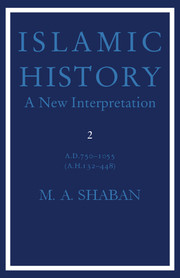Book contents
- Frontmatter
- Contents
- Acknowledgements
- Preface
- 1 The founding of the ʿAbbāsid regime
- 2 Towards a civil war
- 3 Dissolution under a new regime
- 4 The origins of the iqṭāʿ
- 5 Regional economic conflicts
- 6 The breakdown of the central government (I)
- 7 The breakdown of the central government (II)
- 8 The Būyid confederacy
- 9 The Fātimids
- Works cited
- Index
6 - The breakdown of the central government (I)
Published online by Cambridge University Press: 05 June 2012
- Frontmatter
- Contents
- Acknowledgements
- Preface
- 1 The founding of the ʿAbbāsid regime
- 2 Towards a civil war
- 3 Dissolution under a new regime
- 4 The origins of the iqṭāʿ
- 5 Regional economic conflicts
- 6 The breakdown of the central government (I)
- 7 The breakdown of the central government (II)
- 8 The Būyid confederacy
- 9 The Fātimids
- Works cited
- Index
Summary
So far the central government had managed to muddle its way through successive crises and challenges from the provinces and had continued to rule without any solid foundations. Its wealth had helped it to recruit military forces adequate to impose temporary solutions for the many problems in its vast domains. When military measures had failed half-hearted political concessions had been made in the hope that they could be revoked in due course. Any long term policies that had been introduced had had the single aim of strengthening central control without taking regional interests into consideration. The maintenance of this political order depended on the continued flow of revenues from the provinces into the coffers of the central treasury. The increasing tendency in these provinces to take a stand in defence of their economic interests had begun to have its impact on the revenues of the central government and this in turn had affected its ability to mobilize its forces to maintain its rule.
It is most significant that when Muʿtaḍid came to power in 892/279, there were no reserves in the central treasury for the first time in its history. This critical situation demanded immediate rectification. In his ten years' reign, his efforts were doomed to failure because he did not or could not depart from the basic principles of the political orthodoxy of his ancestors.
- Type
- Chapter
- Information
- Islamic HistoryA New Interpretation, pp. 115 - 136Publisher: Cambridge University PressPrint publication year: 1976



